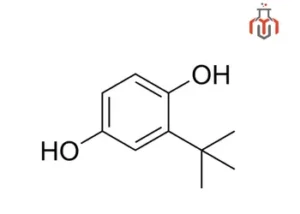
Tert-butyl hydroquinone (TBHQ) is a synthetic antioxidant derivative synthesized by the alkylation of hydroquinone with tert-butyl alcohol (also known as trimethyl carbinol). It is widely used in skincare products, food items, paints, and varnishes to enhance stability and prevent degradation. It extends shelf life and helps preserve the freshness and nutritional value of frozen and packaged foods by preventing rancidity.

CAS No.:1948-33-0
Synonyms:Tert-Butylhydroquinone, TBHQ, 2-tert-Butylhydroquinone, 2-tert-butylbenzene-1,4-diol, Mono-tert-butylhydroquinone
| Physical Properties | |
| Chemical formula | C10H14O2 |
| IUPAC Name | 2-(1,1-dimethylethyl)-1,4-benzenediol |
| Molecular weight | 166.22 g/mol |
| Solubility | Practically insoluble in water, soluble in ethanol, acetone, and ethyl acetate |
| pH | 4.56 at 25 °C |
| Chemical Properties | |
| Color | White to light tan |
| State | Crystalline powder |
| Odor | Slightly aromatic odor |
| Melting point | 126.5-128.5 °C |
| Boiling point | 295 °C |
| Flash point | 171 °C |
| Pictograms : |
|
| Hazard Statements : | H302: Harmful if swallowed. H315: Causes skin irritation. H319: Causes serious eye irritation. H410: Very toxic to aquatic life with long-lasting effects. |
| Precautionary statements : | P501: Dispose of contents/ container to an approved waste disposal plant. P273: Avoid release to the environment. P270: Do not eat, drink, or smoke when using this product. P264: Wash skin thoroughly after handling. P280: Wear protective gloves/ eye protection/ face protection. P302 + P352: IF ON SKIN: Wash with plenty of water. P391: Collect spillage. P337 + P313: If eye irritation persists: Get medical advice/ attention. P305 + P351 + P338: IF IN EYES: Rinse cautiously with water for several minutes. Remove contact lenses, if present, and easy to do. Continue rinsing. P362 + P364: Take off contaminated clothing and wash it before reuse. P332 + P313: If skin irritation occurs: Get medical advice/ attention. |
Tert-butyl hydroquinone (TBHQ) is a synthetic antioxidant derivative synthesized by the alkylation of hydroquinone with tert-butyl alcohol (also known as trimethyl carbinol). It is widely used in skincare products, food items, paints, and varnishes to enhance stability and prevent degradation. It extends shelf life and helps preserve the freshness and nutritional value of frozen and packaged foods by preventing rancidity.

CAS No.:1948-33-0
Synonyms:Tert-Butylhydroquinone, TBHQ, 2-tert-Butylhydroquinone, 2-tert-butylbenzene-1,4-diol, Mono-tert-butylhydroquinone
| Physical Properties | |
| Chemical formula | C10H14O2 |
| IUPAC Name | 2-(1,1-dimethylethyl)-1,4-benzenediol |
| Molecular weight | 166.22 g/mol |
| Solubility | Practically insoluble in water, soluble in ethanol, acetone, and ethyl acetate |
| pH | 4.56 at 25 °C |
| Chemical Properties | |
| Color | White to light tan |
| State | Crystalline powder |
| Odor | Slightly aromatic odor |
| Melting point | 126.5-128.5 °C |
| Boiling point | 295 °C |
| Flash point | 171 °C |
| Pictograms : |
|
| Hazard Statements : | H302: Harmful if swallowed. H315: Causes skin irritation. H319: Causes serious eye irritation. H410: Very toxic to aquatic life with long-lasting effects. |
| Precautionary statements : | P501: Dispose of contents/ container to an approved waste disposal plant. P273: Avoid release to the environment. P270: Do not eat, drink, or smoke when using this product. P264: Wash skin thoroughly after handling. P280: Wear protective gloves/ eye protection/ face protection. P302 + P352: IF ON SKIN: Wash with plenty of water. P391: Collect spillage. P337 + P313: If eye irritation persists: Get medical advice/ attention. P305 + P351 + P338: IF IN EYES: Rinse cautiously with water for several minutes. Remove contact lenses, if present, and easy to do. Continue rinsing. P362 + P364: Take off contaminated clothing and wash it before reuse. P332 + P313: If skin irritation occurs: Get medical advice/ attention. |
Tert-butylhydroquinone is not banned in the United States. The FDA permits its use in food at levels up to 200mg/kg of the oil and fat content.
TBHQ is added in trace amounts to preserve oils and processed food. It has been approved and generally recognized as safe by the U.S. Food and Drug Administration. According FDA its limit should not exceed 0.02% (200 ppm) of a food’s product oil and fat content.
Prolonged intake of TBHQ may impair immune function. It can suppress T cell activation and disrupt the Nrf2 signaling pathway, which plays a key role in regulating antioxidant and immune responses.
The hydroquinone molecule substituted with a tert-butyl group is known as Tert-butylhydroquinone (TBHQ). In this compound, a tert-butyl group (–C(CH₃)₃) replaces one hydrogen atom on the benzene ring of hydroquinone (C₆H₄(OH)₂). This substitution enhances the molecule’s antioxidant properties, making TBHQ widely utilized in food preservation and various industrial applications.